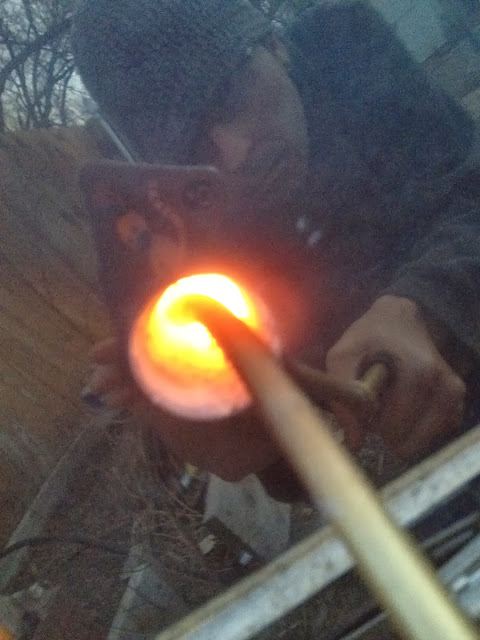Now I can leave this alone, or I can change burners or I can add a burner. The last two would allow me to add the third ring back in. If I add a burner on the side, which I am thinking of doing, I could do so and use this to add wood to the firing adding and taking away the actual burner as I work the say through it. Not totally easy but not too complicated.
Anyway, on to the firing.
So above you can see the kiln finally getting hot. I fired basically all day last time and could not break 700*c but today in an hour I hit over 600*. This picture was taken around the time ^010 fell, so I started reduction which you are seeing the flue setting for below.
I did not take any further pictures (nothing much to see) after I moved back into oxidation and tried to fire up to temp. I was doing good until I hit 4pm. This is almost five hours into the firing and... I was loosing temp. I was not clear why. I played with the flue, the gas level and then found that the top shelf was at 1096*c but the bottom shelf was 1146*c, far more of a difference than I expected given the form of the kiln.
Also my target was ^5 or ^6, whatever I could get to be honest. The estimated temp was between 1200*c to 1255*c, depending on time and such. Well around this time I noticed, ^6 was soft and falling. So I threw the kiln into reduction and removed the thermocoupler. I can't have it in when I am spraying.
Above you can see the flames from this reduction (glaze reduction). I let it sit for around 15min while I did the final prep of the spray. This is 3# in 1 gallon of boiling water. Reduction during this period is totally sealed up except a small slit in the flue. All peeps are closed. I then removed all the peep holes when I was ready to spray. You can see the flames below out the flue.
I was all alone this firing so it was interesting trying to do pix of me spraying. Below is the best I have. You can see the metal sprayer going in the peep hole and of course you can see me and the phone in the reflection. I sprayed in spurts moving from peep hole to peep hole and then pumping more pressure into the sprayer so it will spray. Spraying creates water reduction so the total body reduction time is more like 30 min total.
Once I was done, I threw open the flue. And.. I cracked up the gas. No clue what temp as I wasn't measuring. Instead I cleaned and let it run like this for 30 min.
I then turned off all the gas, closed the peep holes and closed the flue 100% to leave it sealed to cool. Below is the last picture, all gas is off. It was taken right before I closed the flue. In the few seconds it took the camera to focus I could feel the heat on my phone.
So it will now sit till tomorrow when I will check the temp. No opening until it is below 200*F.
To recap. This was a six hour firing. I hit ^010 about 4 hours in and completed a moderate body reduction for an hour.
I struggled with temp around 1130*c, it started to go off. Not clear what I needed to do but as the cones were close enough I called it good.
About five hours in I hit ^5, put it into 30min glaze reduction (heavy reduction with soda added). Soda was 3#/1gal.
Finished it off with 30 min full oxidation and then shut if off and sealed to cool.
This is not very far off my written firing schedule.


































